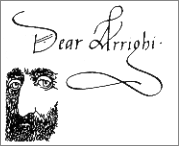

Dear Arrighi,
Why is Italic script the first hand to be taught when it is so much harder to master than some of the other styles?
Signed,
Still StrugglingDear Still Struggling,
In some programs where the students have made a long term commitment, there is a better approach to the order of styles taught. The round shapes of the Roman lowercase are easier to understand and write. Therefore either a bookhand or Foundational hand would be more successful. The problem with this is that most programs that run 6 to 10 weeks have people who want to learn "fancy" writing in as short of time as possible.The bookhands are not "fancy" and look a lot like type, so the students don't feel like they are doing "calligraphy". The Italic hand and Copperplate seem to fit the bill for a useful hand that the beginning student will be happy with. I rarely have a call for bookhand for addressing envelopes and many students take calligraphy so they can address pretty envelopes.
The problem with Italic is the subtle branching curves and elliptical shapes. They are much more difficult to understand and ultimately to write. The spacing in Italic is also more sophisticated and less natural than the closer spacing of the round Roman forms.
It is hard enough in most Adult School and college programs to attract and keep enough students to keep calligraphy classes going so you have to compromise the "best" approach for the most popular approach. Hopefully, the students will continue taking various classes so they will learn all the different styles, and decide for themselves which one fits their natural style the most.
My best advice, regardless of the style that you are learning, is to really listen to what the teacher says, look carefully at the exemplar (not what you think the letter looks like, but what it REALLY looks like) and emulate it as close as possible. Look at the exemplar frequently or you will just continue to practice the wrong shape over and over. Watch the teacher write and notice the way they sit, hold the pen and paper. Where have they set the exemplar, what are they doing with their other hand? This will help you learn much more quickly. Even though it's slower to begin with (you'll only have one good page instead of three bad pages) but you are training your head, hand and eye to understand the movements and shapes. Lastly, try not to be too much of a perfectionist so that you are never happy with the progress that you are making. Have fun, which ever style you're learning and enjoy the process!
Signed,
Arrighi